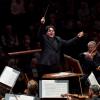
Hearty helpings of two Jean Sibelius staples were on the menu April 27–30 at Davies Symphony Hall. Guest conductor Dalia Stasevska, soloist Joshua Bell, and the San Francisco Symphony made a feast of them.
Bell, the phenomenally gifted fiddler and musical emissary who made his SF Symphony solo debut in 1991, was the headliner who drew a large crowd for Sunday’s final performance of the weekend. If even the loftiest expectations can be exceeded, Bell did just that in the Violin Concerto in D Minor. Assured and artful in every respect, the performance built finely wrought details into a musical narrative at once inevitable and wondrously new.
The transports began from the outset, with Bell’s exquisitely delicate reading on the concerto’s tender opening line over the orchestra’s softly oscillating strings. Soon enough, the soloist was gliding into fluid double stops and suave passagework, making the gymnastics all seem perfectly natural. An early mini-cadenza established Bell’s decisive but never pungent approach to the movement and the piece as a whole.
Even in the most challenging passages, Bell conveyed a sense of patient purpose, as if he were musing along with the composer, balancing and echoing phrases, hearing and registering inner voices. Near the end of the first movement, the performance bristled with tightly coiled melodies, dark but luminous, intense but discriminating, and all carefully balanced.

Stasevska, a diminutive yet commanding presence on the podium, partnered attentively with Bell. The woodwinds brought a choice amber tone to the opening measures of the Adagio. the texture brightening with the soloist’s flurry of still more expertly executed double stops. The movement played out in an undulating, unbroken line, ending with the soloist’s long, dying-away sigh.
Bell, who once busked in the Washington, D.C. subway as a test of public oblivion to great music when it’s out of context, flashed a frisky ebullience in the concerto’s galloping finale. The soloist and orchestra rode at full tilt, with rhythmic acuity and drive. Bell turned the late-movement harmonics into a high-wire act without a screech or a stumble. It was like an airy dessert to finish off a gratifying full meal.
The expansive sprawl of Sibelius’s Symphony No. 2 in D Major occupied the second half of the program. Stasevska took her time to explore the work’s nooks and vistas, its depths and promontories. From the gradually accreting tension of the first movement to the dramatic emergence from a minor key to the fanfare-signaled return to D major at the end, the performance felt fully realized.
Getting one blurry cutoff out of the way early on, the orchestra responded to the conductor’s upsweeping gestures and embracing, widespread arms. The cello and bass pizzicati that open the Andante had a sonorous ripeness. Stasevska extended the movement’s pauses between subjects into pools of contemplation of what had just been and what was to come. The high contrasts of “Vivacissimo” and “Lento e suave” gave the third movement a chiaroscuro play of light and shadow, briskness and bleakness. It all ended in a combustible blaze of hard-won glory, with the brasses singing out over ascendant strings.
Even as the audience cheered and cheered some more for the double Sibelius triumph, the program’s apt six-minute curtain-raiser was not forgotten. Anna Meredith’s’s Nautilus (2011), arranged for orchestra from its origins as an electronic synth track on the composer’s Varmints album, turned a repeated-note pulse beat into a brightly colored, brashly forthright celebration of rising forces. The tuba and chimes, not often paired, stood out in one brawny exchange.
Sibelius’s Second Symphony begins in a similar vein, with the strings sending out a quickening heartbeat figure. At Davies, the past wound up echoing the present of Meredith’s pulse-pounding joyride.




